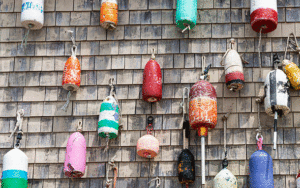Each year, the PEI Aquaculture Alliance and the provincial government of Prince Edward Island in Canada organize shoreline cleanups of the island province. Along with traps, ropes, bottles, and household debris, the volunteers always find plenty of fragments of expanded polystyrene (Styrofoam) buoys. The buoys, which first began to be used by fishermen during World War II, can easily break apart when exposed to rough seas or too much sunlight, or when burrowed into by sea creatures.
Recently, however, the Alliance completed an effort to swap out some 87,000 Styrofoam buoys for new high-density polyethylene buoys which are much less likely to break apart. The Alliance received some $270,000 (Canadian) in funding from the federal and provincial governments to buy the new buoys and dispose of the old ones.

Peter Warris, the Alliance’s director of projects and industry liaison, said the island’s mussel and oyster farmers were eager to take part in the program because of Canadian organic food certification standards. PEI supplies some 80 percent of the mussels for North America, and some growers have worked with the Alliance to receive organic certification which can net them a higher price in the marketplace.
While aquaculture production of filter-feeding shellfish is generally regarded as fairly “green” and sustainable, Canadian organic certification encourages the switch from Styrofoam buoys to new ones with harder outer plastic shells, Warris said.
“They’ll allow you to continue using the Styrofoam ones that you’ve got, but once it reaches its end of life, the requirement is that you replace it with hard plastic,” he said.
As traditional Styrofoam buoys crumble, they can cause deadly digestive issues and reduced fertility in sea creatures…
Warris added that more than 20 local mussel and oyster growers took part in the buoy program. At first, a few individual growers applied for funding to replace buoys, but then the Alliance began to work with PEI’s Department of Fisheries and Communities to organize these requests.
The organization coordinated with local officials to seek a grant through Canada’s Fisheries and Aquaculture Clean Technology Adoption Program, said Kim Gill, manager of aquaculture with the province’s Department of Agriculture and Fisheries.
“We had a lot of individual growers approaching us for smaller projects. It’s a lot of administration,” Gill said. “So what the aquaculture alliance did was they suggested a larger funded program, and then they administered specific projects with these industry members.”
PEI is small in population—157,000—and in geography—about twice the size of Rhode Island—and Gill said the collective familiarity there may be part of the reason provincial officials and the local aquaculture industry have a good history of working together.
“We have good lines of communication,” she said. “Industry is really the backbone of all that happens moving things forward in terms of product development, and even gear and infrastructure changes.”
As traditional Styrofoam buoys crumble, they can cause deadly digestive issues and reduced fertility in sea creatures that ingest the plastic bits, according to Flora and Fauna International, a wildlife conservation organization based in the United Kingdom. The government of South Korea recently pledged to replace all Styrofoam buoys used in its fisheries with more eco-friendly options by 2025, according to a report in Aju Business Daily, a South Korean newspaper. In Canada, there was a smaller buoy replacement program that took place in the province of British Columbia.
The 87,000 buoys replaced in the waters off Prince Edward Island represent just 6 percent of those used by the island’s aquaculture industry, according to Warris. After the initial success of this buoy swap, Warris said the Alliance will look for more grant opportunities to continue this transition away from Styrofoam buoys. It’s just part of the changing nature of the industry, he said.
“From what I understand, people were using empty bottles as floatation in the past,” Warris said. “You continue to evolve, and you continue to change your best practices.”

